The choice of a retention tank is subject to the regulations on the storage of polluting and dangerous liquids.
The decree of 19 July 2018 stipulates the retention conditions for the storage of a liquid that could create water or soil pollution.
To help you comply with the law, Axesspack can help you determine the retention capacity you need.
1. Choose my retention tank according to the product stored
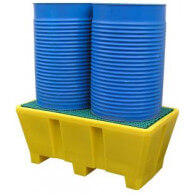
Polyethylene tank
| YES | Polluting, noxious, toxic, aggressive chemical products (e.g. acids, bases, etc.) |
| NO | Not suitable for flammable products |
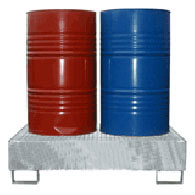
Galvanised steel tank
| YES | Oils, solvents, paints, hydrocarbons, polluting or inflammable products |
| NO | Not suitable for corrosive chemicals |
2. Determine the appropriate retention capacity
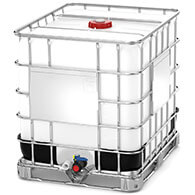
Container of more than 250 litres
You store at least one container with a unit capacity of more than 250 Litres
(e.g. an IBC)
100% of the capacity of the largest container
or
50% of the total stored capacity
(the larger of the 2 values should be used as the minimum retention)
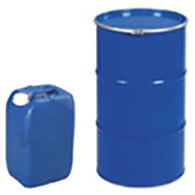
Container of less than 250 litres
You store one or more containers with a unit capacity of less than 250 Litres
(e.g.: drum, can or jerry can)
There are two possible scenarios:
a. In the case of flammable liquids (with the exception of lubricants)
Total capacity of all containers | Retention capacity |
| Less than 800 litres (< 800 L) | 100% of total capacity |
| from 800 litres to 1600 litres | 800 litres |
| More than 1600 litres (> 1600 L) | 50% of total capacity |
b. other liquids
Total capacity of all containers | Retention capacity |
| Less than 800 litres (< 800 L) | 100% of total capacity |
| de 800 litres à 4000 litres | 800 litres |
| More than 4000 litres (> 4000 L) | 20% of total capacity |
3. I want to store different products on the same retention, are they compatible with each other?
If you store different chemical liquids, it is essential to check that they are compatible in order to use the same drip tray. Indeed, mixing certain products together can be dangerous (release of vapours, change in corrosion properties, etc.). Please refer to the chemical incompatibility table below.
Extracts from the decree of 02 February 1998, section 3 article 10: "Tanks or containers containing incompatible products are not associated with the same retention tank.
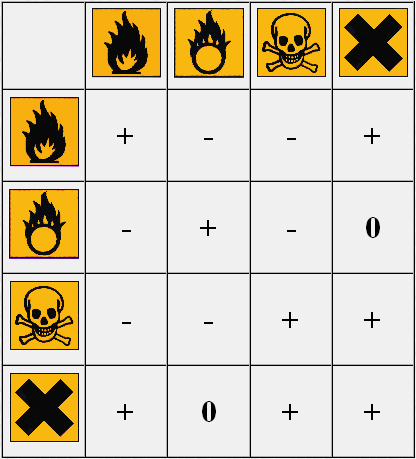
Chemical incompatibility table
Caption: = Flammable;
= Flammable;  = Combustibles;
= Combustibles;  = Toxics;
= Toxics;  = Harmful / irritants
= Harmful / irritants
"-" should not be stored together,
"0" should only be stored together if certain conditions are met,
"+" can be stored together.
4. The Order of 19 July 2018
Chapter II: Prevention of accidents and accidental pollution, including rainwater
Article 7:
The operator shall take all necessary measures in the design, construction and operation of the installations to limit the risks of accidental pollution of the air, water or soil.
Section 4 Article 25 :
I. Any storage of a liquid likely to cause water or soil pollution is associated with a retention capacity whose volume is at least equal to the greater of the following two values
- 100% of the capacity of the largest tank
- 50% of the total capacity of the associated tanks.
For the storage of containers with a unit capacity of 250 litres or less, the retention capacity is at least equal to
- in the case of flammable liquids, with the exception of lubricants, 50% of the total capacity of the drums,
- in other cases, 20% of the total capacity of the drums,
- in all cases, at least 800 litres or equal to the total capacity when this is less than 800 litres.
II. The retention capacity is impervious to the products it may contain and is resistant to the physical and chemical action of fluids. The same applies to its closing device which is kept closed.
It must be possible to check the tightness of the associated tank(s) at any time.
Products recovered in the event of an accident may only be released under conditions that comply with this decree or are disposed of as waste.
Tanks or containers containing incompatible products must not be associated with the same retention tank.
The storage of flammable liquids, as well as other toxic, corrosive or environmentally hazardous products, is only authorised below ground level in tanks in a masonry pit or similar, and for flammable liquids, under the conditions stated above.
III. The loading and unloading areas for tanker vehicles are watertight and connected to retention areas sized according to the same rules.
The transport of products within the establishment is carried out with the necessary precautions to avoid accidental spillage of packaging (securing of drums, etc.)
The storage and handling of dangerous or polluting products, solid or liquid (or liquefied) are carried out on watertight areas equipped to recover any leaks.
The storage of waste likely to contain polluting products is carried out on watertight areas equipped for the recovery of run-off water.
Article 11:
The operator shall have documents enabling him to know the nature and risks of the hazardous products present in the installation; the safety data sheets provided for in the Labour Code shall meet this obligation.
Inside the authorised classified installation, the drums, tanks and other packaging bear the name of the products and the danger symbols in very legible characters in accordance, if necessary, with the regulations relating to the labelling of dangerous chemical substances and preparations.
